by Corey Hockett
The air was cold. A chilly breeze wafted through the canopy, expunging the energy of the early-morning sun. I sat against a tree sipping coffee, eyes fixed on Michael, who was nearing the crux. He’d looked smooth and confident for the first part of the route, but now the wall was a lot steeper. He was 15 feet above a ledge on a lengthy runout and getting visibly nervous.
Shifting to and fro, trying to figure out the sequence, his technique crumbled with each passing minute. Pretty soon, with frantic breaths, he clung statically to the wall, clearly unable to solve the problem. Ashley, his belayer, stood firm, attentive, and ready to catch him.
Eh, ahh, shit! He struggled. Then he came off.
His fall ended in an abrupt foot-first collision with the ledge, sending a harrowing crack echoing across the drainage. By the time Ashley lowered him to the ground, both of his ankles were black and blue and abnormally swollen—one was the size of a softball. Aside from his upper body, he was completely immobile.
In a flurry, my mind raced back to the Wilderness First Responder course I’d taken a few months prior. ABCs, check the spine, stabilize the injury. With the help of a few others close by, we splinted his ankles with sticks, shirts, and an ace bandage. Then we created a carrying system to haul him off the mountain. Luckily, it was only a half-mile to a lake with boat access. We called the professionals, and by the time we reached the shore they were there to take him the rest of the way.
It was a humbling experience, a reminder that things can go wrong in the blink of an eye. But all things considered, they could’ve gone a lot worse, and for avoiding that fate, we had our wilderness-medicine training to thank. If you want to maximize safety while off the beaten path, you too will sign up for a backcountry medicine course. In Bozeman, there are plenty.
Wilderness First Aid
If you need to know anything at all, it’s the basics. This quick, two-day course runs the gamut of all outdoor emergencies. Covering everything from spine injuries, to heat illness, to anaphylaxis, a Wilderness First Aid course lays the groundwork for how to act when things go wrong. Additionally, CPR certifications are usually offered with most programs. Local courses are offered through Aerie, Crossing Latitudes, MSU, and the Peak in Butte.
Wilderness First Responder
If you’re looking to gain a little more knowledge than just the fundamentals (and you should) then consider taking a Wilderness First Responder (WFR). Typically around 80 hours of classroom and field time, a WFR dives thoroughly into patient assessment. Learn how to identify specific types of trauma, deal with medical ailments, and build makeshift litters to evacuate the injured. Aerie, Crossing Latitudes, and MSU provide instruction locally.
Wilderness EMT
If becoming a guide or medical professional sounds enticing, you’ll likely need to take a Wilderness EMT. This intensive 200-hour program covers and combines both urban and backcountry medicine practices ensuring you leave the course a medical expert. Study anatomy and physiology, practice vehicle extrication, and spend full days working through intense backcountry rescue missions. Look for local programs through Aerie and Crossing Latitudes.
In the backcountry, when things go bad, they can go terribly wrong. The best we can do is prepare for the unexpected ahead of time. As Shakespeare said: All things are ready, if our mind be so. If you like to get after it outside, do yourself—as well as your adventure partners—a favor. Get some wilderness medicine education.

